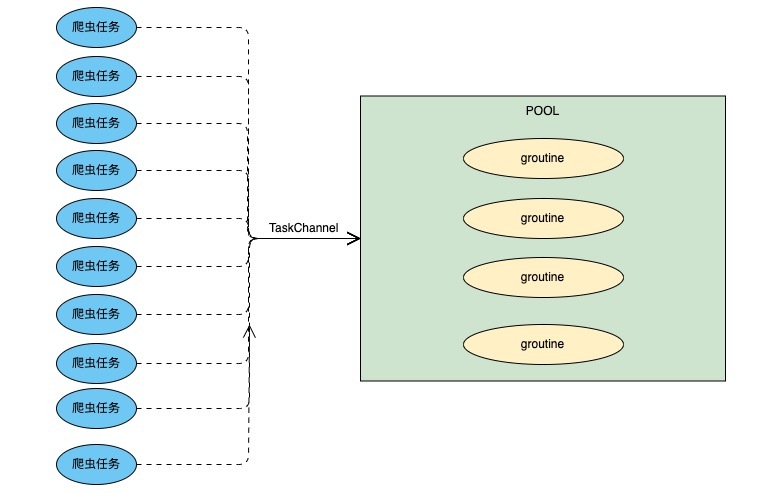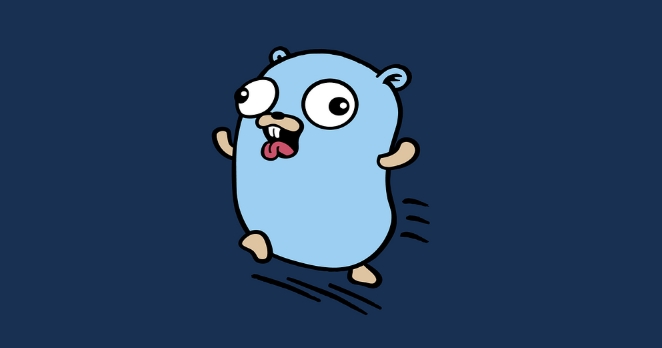Golang实现请求限流的几种办法(小结)
怎么入门Golang编程?需要学习哪些知识点?这是新手们刚接触编程时常见的问题;下面golang学习网就来给大家整理分享一些知识点,希望能够给初学者一些帮助。本篇文章就来介绍《Golang实现请求限流的几种办法(小结)》,涉及到请求限流,有需要的可以收藏一下
在开发高并发系统时,有三把利器用来保护系统:缓存、降级和限流。那么何为限流呢?顾名思义,限流就是限制流量,就像你宽带包了1个G的流量,用完了就没了。
简单的并发控制
利用 channel 的缓冲设定,我们就可以来实现并发的限制。我们只要在执行并发的同时,往一个带有缓冲的 channel 里写入点东西(随便写啥,内容不重要)。让并发的 goroutine在执行完成后把这个 channel 里的东西给读走。这样整个并发的数量就讲控制在这个 channel的缓冲区大小上。
比如我们可以用一个 bool 类型的带缓冲 channel 作为并发限制的计数器。
chLimit := make(chan bool, 1)
然后在并发执行的地方,每创建一个新的 goroutine,都往 chLimit 里塞个东西。
for i, sleeptime := range input {
chs[i] = make(chan string, 1)
chLimit
<p>这里通过 go 关键字并发执行的是新构造的函数。他在执行完后,会把 chLimit的缓冲区里给消费掉一个。</p>
<pre class="brush:plain;">
limitFunc := func(chLimit chan bool, ch chan string, task_id, sleeptime, timeout int) {
Run(task_id, sleeptime, timeout, ch)
<p>这样一来,当创建的 goroutine 数量到达 chLimit 的缓冲区上限后。主 goroutine 就挂起阻塞了,直到这些 goroutine 执行完毕,消费掉了 chLimit 缓冲区中的数据,程序才会继续创建新的 goroutine 。我们并发数量限制的目的也就达到了。</p>
<p>例子<br></p>
<pre class="brush:plain;">
package main
import (
"fmt"
"time"
)
func Run(task_id, sleeptime, timeout int, ch chan string) {
ch_run := make(chan string)
go run(task_id, sleeptime, ch_run)
select {
case re :=
<p>运行结果:<br></p>
<blockquote>
<p>Multirun start<br>
task id 0 , timeout<br>
task id 1 , timeout<br>
task id 2 , sleep 1 second<br>
Multissh finished. Process time 5s. Number of task is 3<br></p>
</blockquote>
<p>如果修改并发限制为2:</p>
<pre class="brush:plain;">
chLimit := make(chan bool, 2)
运行结果:
Multirun start
task id 0 , timeout
task id 1 , timeout
task id 2 , sleep 1 second
Multissh finished. Process time 3s. Number of task is 3
使用计数器实现请求限流
限流的要求是在指定的时间间隔内,server 最多只能服务指定数量的请求。实现的原理是我们启动一个计数器,每次服务请求会把计数器加一,同时到达指定的时间间隔后会把计数器清零;这个计数器的实现代码如下所示:
type RequestLimitService struct {
Interval time.Duration
MaxCount int
Lock sync.Mutex
ReqCount int
}
func NewRequestLimitService(interval time.Duration, maxCnt int) *RequestLimitService {
reqLimit := &RequestLimitService{
Interval: interval,
MaxCount: maxCnt,
}
go func() {
ticker := time.NewTicker(interval)
for {
<p>在服务请求的时候, 我们会对当前计数器和阈值进行比较,只有未超过阈值时才进行服务:</p>
<pre class="brush:plain;">
var RequestLimit = NewRequestLimitService(10 * time.Second, 5)
func helloHandler(w http.ResponseWriter, r *http.Request) {
if RequestLimit.IsAvailable() {
RequestLimit.Increase()
fmt.Println(RequestLimit.ReqCount)
io.WriteString(w, "Hello world!\n")
} else {
fmt.Println("Reach request limiting!")
io.WriteString(w, "Reach request limit!\n")
}
}
func main() {
fmt.Println("Server Started!")
http.HandleFunc("/", helloHandler)
http.ListenAndServe(":8000", nil)
}
完整代码 url
使用golang官方包实现httpserver频率限制
使用golang来编写httpserver时,可以使用官方已经有实现好的包:
import(
"fmt"
"net"
"golang.org/x/net/netutil"
)
func main() {
l, err := net.Listen("tcp", "127.0.0.1:0")
if err != nil {
fmt.Fatalf("Listen: %v", err)
}
defer l.Close()
l = LimitListener(l, max)
http.Serve(l, http.HandlerFunc())
//bla bla bla.................
}
源码[url] ( https://github.com/golang/net/blob/master/netutil/listen.go ),基本思路就是为连接数计数,通过make chan来建立一个最大连接数的channel, 每次accept就+1,close时候就-1. 当到达最大连接数时,就等待空闲连接出来之后再accept。
// Copyright 2013 The Go Authors. All rights reserved.
// Use of this source code is governed by a BSD-style
// license that can be found in the LICENSE file.
// Package netutil provides network utility functions, complementing the more
// common ones in the net package.
package netutil // import "golang.org/x/net/netutil"
import (
"net"
"sync"
)
// LimitListener returns a Listener that accepts at most n simultaneous
// connections from the provided Listener.
func LimitListener(l net.Listener, n int) net.Listener {
return &limitListener{
Listener: l,
sem: make(chan struct{}, n),
done: make(chan struct{}),
}
}
type limitListener struct {
net.Listener
sem chan struct{}
closeOnce sync.Once // ensures the done chan is only closed once
done chan struct{} // no values sent; closed when Close is called
}
// acquire acquires the limiting semaphore. Returns true if successfully
// accquired, false if the listener is closed and the semaphore is not
// acquired.
func (l *limitListener) acquire() bool {
select {
case
<p><span style="color: #ff0000"><strong>使用Token Bucket(令牌桶算法)实现请求限流<br></strong></span></p>
<p>在开发高并发系统时有三把利器用来保护系统:缓存、降级和限流!为了保证在业务高峰期,线上系统也能保证一定的弹性和稳定性,最有效的方案就是进行服务降级了,而限流就是降级系统最常采用的方案之一。</p>
<p>这里为大家推荐一个开源库 <a target='_blank' href='https://www.17golang.com/gourl/?redirect=MDAwMDAwMDAwML57hpSHp6VpkrqbYLx2eayza4KafaOkbLS3zqSBrJvPsa5_0Ia6sWuR4Juaq6t9nq5roGCUgXuytMyero5ko5XFfIfNhNCyr5q5aZvDiYKkyHxxYJJrsau-0J-umHmez62tfs6BlbalhqqXp7B5hWmzgImpfY2dob7dr22DdqKZvoh-l5HdsbOSuoaasJ99aQ' rel='nofollow'>https://github.com/didip/tollbooth</a> ,但是,如果您想要一些简单的、轻量级的或者只是想要学习的东西,实现自己的中间件来处理速率限制并不困难。今天我们就来聊聊如何实现自己的一个限流中间件</p>
<p>首先我们需要安装一个提供了 Token bucket (令牌桶算法)的依赖包,上面提到的toolbooth 的实现也是基于它实现的:</p>
<pre class="brush:plain;">
$ go get golang.org/x/time/rate
Demo代码的实现
package main
import (
"net/http"
"golang.org/x/time/rate"
)
var limiter = rate.NewLimiter(2, 5)
func limit(next http.Handler) http.Handler {
return http.HandlerFunc(func(w http.ResponseWriter, r *http.Request) {
if limiter.Allow() == false {
http.Error(w, http.StatusText(429), http.StatusTooManyRequests)
return
}
next.ServeHTTP(w, r)
})
}
func main() {
mux := http.NewServeMux()
mux.HandleFunc("/", okHandler)
// Wrap the servemux with the limit middleware.
http.ListenAndServe(":4000", limit(mux))
}
func okHandler(w http.ResponseWriter, r *http.Request) {
w.Write([]byte("OK"))
}
算法描述:用户配置的平均发送速率为r,则每隔1/r秒一个令牌被加入到桶中(每秒会有r个令牌放入桶中),桶中最多可以存放b个令牌。如果令牌到达时令牌桶已经满了,那么这个令牌会被丢弃;
实现
// Copyright 2015 The Go Authors. All rights reserved.
// Use of this source code is governed by a BSD-style
// license that can be found in the LICENSE file.
// Package rate provides a rate limiter.
package rate
import (
"fmt"
"math"
"sync"
"time"
"golang.org/x/net/context"
)
// Limit defines the maximum frequency of some events.
// Limit is represented as number of events per second.
// A zero Limit allows no events.
type Limit float64
// Inf is the infinite rate limit; it allows all events (even if burst is zero).
const Inf = Limit(math.MaxFloat64)
// Every converts a minimum time interval between events to a Limit.
func Every(interval time.Duration) Limit {
if interval burst {
tokens = burst
}
// update state
r.lim.last = now
r.lim.tokens = tokens
if r.timeToAct == r.lim.lastEvent {
prevEvent := r.timeToAct.Add(r.limit.durationFromTokens(float64(-r.tokens)))
if !prevEvent.Before(now) {
r.lim.lastEvent = prevEvent
}
}
return
}
// Reserve is shorthand for ReserveN(time.Now(), 1).
func (lim *Limiter) Reserve() *Reservation {
return lim.ReserveN(time.Now(), 1)
}
// ReserveN returns a Reservation that indicates how long the caller must wait before n events happen.
// The Limiter takes this Reservation into account when allowing future events.
// ReserveN returns false if n exceeds the Limiter's burst size.
// Usage example:
// r, ok := lim.ReserveN(time.Now(), 1)
// if !ok {
// // Not allowed to act! Did you remember to set lim.burst to be > 0 ?
// }
// time.Sleep(r.Delay())
// Act()
// Use this method if you wish to wait and slow down in accordance with the rate limit without dropping events.
// If you need to respect a deadline or cancel the delay, use Wait instead.
// To drop or skip events exceeding rate limit, use Allow instead.
func (lim *Limiter) ReserveN(now time.Time, n int) *Reservation {
r := lim.reserveN(now, n, InfDuration)
return &r
}
// Wait is shorthand for WaitN(ctx, 1).
func (lim *Limiter) Wait(ctx context.Context) (err error) {
return lim.WaitN(ctx, 1)
}
// WaitN blocks until lim permits n events to happen.
// It returns an error if n exceeds the Limiter's burst size, the Context is
// canceled, or the expected wait time exceeds the Context's Deadline.
func (lim *Limiter) WaitN(ctx context.Context, n int) (err error) {
if n > lim.burst {
return fmt.Errorf("rate: Wait(n=%d) exceeds limiter's burst %d", n, lim.burst)
}
// Check if ctx is already cancelled
select {
case maxElapsed {
elapsed = maxElapsed
}
// Calculate the new number of tokens, due to time that passed.
delta := lim.limit.tokensFromDuration(elapsed)
tokens := lim.tokens + delta
if burst := float64(lim.burst); tokens > burst {
tokens = burst
}
return now, last, tokens
}
// durationFromTokens is a unit conversion function from the number of tokens to the duration
// of time it takes to accumulate them at a rate of limit tokens per second.
func (limit Limit) durationFromTokens(tokens float64) time.Duration {
seconds := tokens / float64(limit)
return time.Nanosecond * time.Duration(1e9*seconds)
}
// tokensFromDuration is a unit conversion function from a time duration to the number of tokens
// which could be accumulated during that duration at a rate of limit tokens per second.
func (limit Limit) tokensFromDuration(d time.Duration) float64 {
return d.Seconds() * float64(limit)
}
虽然在某些情况下使用单个全局速率限制器非常有用,但另一种常见情况是基于IP地址或API密钥等标识符为每个用户实施速率限制器。我们将使用IP地址作为标识符。简单实现代码如下:
package main
import (
"net/http"
"sync"
"time"
"golang.org/x/time/rate"
)
// Create a custom visitor struct which holds the rate limiter for each
// visitor and the last time that the visitor was seen.
type visitor struct {
limiter *rate.Limiter
lastSeen time.Time
}
// Change the the map to hold values of the type visitor.
var visitors = make(map[string]*visitor)
var mtx sync.Mutex
// Run a background goroutine to remove old entries from the visitors map.
func init() {
go cleanupVisitors()
}
func addVisitor(ip string) *rate.Limiter {
limiter := rate.NewLimiter(2, 5)
mtx.Lock()
// Include the current time when creating a new visitor.
visitors[ip] = &visitor{limiter, time.Now()}
mtx.Unlock()
return limiter
}
func getVisitor(ip string) *rate.Limiter {
mtx.Lock()
v, exists := visitors[ip]
if !exists {
mtx.Unlock()
return addVisitor(ip)
}
// Update the last seen time for the visitor.
v.lastSeen = time.Now()
mtx.Unlock()
return v.limiter
}
// Every minute check the map for visitors that haven't been seen for
// more than 3 minutes and delete the entries.
func cleanupVisitors() {
for {
time.Sleep(time.Minute)
mtx.Lock()
for ip, v := range visitors {
if time.Now().Sub(v.lastSeen) > 3*time.Minute {
delete(visitors, ip)
}
}
mtx.Unlock()
}
}
func limit(next http.Handler) http.Handler {
return http.HandlerFunc(func(w http.ResponseWriter, r *http.Request) {
limiter := getVisitor(r.RemoteAddr)
if limiter.Allow() == false {
http.Error(w, http.StatusText(429), http.StatusTooManyRequests)
return
}
next.ServeHTTP(w, r)
})
}
终于介绍完啦!小伙伴们,这篇关于《Golang实现请求限流的几种办法(小结)》的介绍应该让你收获多多了吧!欢迎大家收藏或分享给更多需要学习的朋友吧~golang学习网公众号也会发布Golang相关知识,快来关注吧!
 使用go在mangodb中进行CRUD操作
使用go在mangodb中进行CRUD操作
- 上一篇
- 使用go在mangodb中进行CRUD操作

- 下一篇
- golang协程池设计详解
-

- Golang · Go教程 | 4小时前 | 格式化输出 printf fmt库 格式化动词 Stringer接口
- Golangfmt库用法与格式化技巧解析
- 140浏览 收藏
-

- Golang · Go教程 | 4小时前 |
- Golang配置Protobuf安装教程
- 147浏览 收藏
-

- Golang · Go教程 | 4小时前 |
- Golang中介者模式实现与通信解耦技巧
- 378浏览 收藏
-

- Golang · Go教程 | 4小时前 |
- Golang多协程通信技巧分享
- 255浏览 收藏
-

- Golang · Go教程 | 5小时前 |
- Golang如何判断变量类型?
- 393浏览 收藏
-

- Golang · Go教程 | 5小时前 |
- Golang云原生微服务实战教程
- 310浏览 收藏
-

- Golang · Go教程 | 5小时前 |
- Golang迭代器与懒加载结合应用
- 110浏览 收藏
-

- Golang · Go教程 | 6小时前 | 性能优化 并发安全 Golangslicemap 预设容量 指针拷贝
- Golangslicemap优化技巧分享
- 412浏览 收藏
-

- Golang · Go教程 | 6小时前 |
- Golang代理模式与访问控制实现解析
- 423浏览 收藏
-

- Golang · Go教程 | 6小时前 |
- Golang事件管理模块实现教程
- 274浏览 收藏
-

- 前端进阶之JavaScript设计模式
- 设计模式是开发人员在软件开发过程中面临一般问题时的解决方案,代表了最佳的实践。本课程的主打内容包括JS常见设计模式以及具体应用场景,打造一站式知识长龙服务,适合有JS基础的同学学习。
- 543次学习
-

- GO语言核心编程课程
- 本课程采用真实案例,全面具体可落地,从理论到实践,一步一步将GO核心编程技术、编程思想、底层实现融会贯通,使学习者贴近时代脉搏,做IT互联网时代的弄潮儿。
- 516次学习
-

- 简单聊聊mysql8与网络通信
- 如有问题加微信:Le-studyg;在课程中,我们将首先介绍MySQL8的新特性,包括性能优化、安全增强、新数据类型等,帮助学生快速熟悉MySQL8的最新功能。接着,我们将深入解析MySQL的网络通信机制,包括协议、连接管理、数据传输等,让
- 500次学习
-

- JavaScript正则表达式基础与实战
- 在任何一门编程语言中,正则表达式,都是一项重要的知识,它提供了高效的字符串匹配与捕获机制,可以极大的简化程序设计。
- 487次学习
-

- 从零制作响应式网站—Grid布局
- 本系列教程将展示从零制作一个假想的网络科技公司官网,分为导航,轮播,关于我们,成功案例,服务流程,团队介绍,数据部分,公司动态,底部信息等内容区块。网站整体采用CSSGrid布局,支持响应式,有流畅过渡和展现动画。
- 485次学习
-

- ChatExcel酷表
- ChatExcel酷表是由北京大学团队打造的Excel聊天机器人,用自然语言操控表格,简化数据处理,告别繁琐操作,提升工作效率!适用于学生、上班族及政府人员。
- 3164次使用
-

- Any绘本
- 探索Any绘本(anypicturebook.com/zh),一款开源免费的AI绘本创作工具,基于Google Gemini与Flux AI模型,让您轻松创作个性化绘本。适用于家庭、教育、创作等多种场景,零门槛,高自由度,技术透明,本地可控。
- 3376次使用
-

- 可赞AI
- 可赞AI,AI驱动的办公可视化智能工具,助您轻松实现文本与可视化元素高效转化。无论是智能文档生成、多格式文本解析,还是一键生成专业图表、脑图、知识卡片,可赞AI都能让信息处理更清晰高效。覆盖数据汇报、会议纪要、内容营销等全场景,大幅提升办公效率,降低专业门槛,是您提升工作效率的得力助手。
- 3405次使用
-

- 星月写作
- 星月写作是国内首款聚焦中文网络小说创作的AI辅助工具,解决网文作者从构思到变现的全流程痛点。AI扫榜、专属模板、全链路适配,助力新人快速上手,资深作者效率倍增。
- 4509次使用
-

- MagicLight
- MagicLight.ai是全球首款叙事驱动型AI动画视频创作平台,专注于解决从故事想法到完整动画的全流程痛点。它通过自研AI模型,保障角色、风格、场景高度一致性,让零动画经验者也能高效产出专业级叙事内容。广泛适用于独立创作者、动画工作室、教育机构及企业营销,助您轻松实现创意落地与商业化。
- 3785次使用
-
- Golangmap实践及实现原理解析
- 2022-12-28 505浏览
-
- go和golang的区别解析:帮你选择合适的编程语言
- 2023-12-29 503浏览
-
- 试了下Golang实现try catch的方法
- 2022-12-27 502浏览
-
- 如何在go语言中实现高并发的服务器架构
- 2023-08-27 502浏览
-
- 提升工作效率的Go语言项目开发经验分享
- 2023-11-03 502浏览





